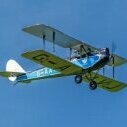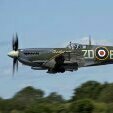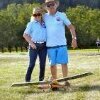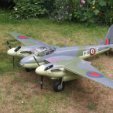Leaderboard
Popular Content
Showing content with the highest reputation on 11/04/24 in all areas
-
I may not have the kit yet but the pilot is ready And just in case the scale is wrong, here are his smaller brothers, Tiny Tim and Really Tiny Im4 points
-
Very simply ,your engine looses a few revs as the glow plug cools slightly without the electrical current to heat the coil. This efectively retards the timing slightly. As already said other factor all play a roll in the timing of a glow engines. If glow plugs are very old this slowing can be more noticeable. For the same reason you should never run a glow engine at full thtottle with the glow swithched on as this can cause pre ignition or knock and damage the engine resulting in extreme cases with a hole in the piston crown. Prop throwing is a prime example of over advanced ignition often caused by a weak mixture at full throttle. This knock will also shorten the plug life. Modern designs have to a greater degree engineered out this extreme knock. Assuming mixture is correct then its perfectly normal. If the coil in your engines glowplug looks white an crystally instead of silver then its getting past it. If engine still runs reliably apart from that then just fly it. Us oldies will remember when fiddling with our cars that if the timing was set wrong we heard a tingling sound , a bit like the sound made when tapping the bottom of a cup with a pencil . This only occured when engine is under load as when accelerating , its called pinking. Also heard is a lower octane fuel than the engine was designed for was used.3 points
-
Also worth adding; at idle - with the engine running at a vacuum in the intake, there is comparatively little air/fuel charge to be compressed, with a low amount of compression comes a low amount of heating of the intake charge at full throttle - the engine is running wide open, a much larger air/fuel charge enters the motor, thus more compression occurs, and with more compression comes a larger increase of charge temperature the hotter mixture contributes to the advance of ignition "Diesel engines or compression ignition" Technically, glow engines are compression ignition - aided and abetted by the catalyst in the glow plug of course.2 points
-
Plenty comments as usual, small petrols are rubbish, blah blah. My NGH is 17cc, loadsa grunt, never failed, seems to be another user here. They're noisey ? aye and the bigger 2 stroke glow are not ? Some 4 strokes fail the 82 db test. For the record, again. Using I.C can bring noise issues, IF the user doesn't take steps to address it, it ain't a new thing.2 points
-
Just checked the stats on this, its listed as 61" and 9lbs finished weight. I'd go for a 120 glow four stroke. Plenty on Ebay as a second hand.2 points
-
2 points
-
Well the Hurricane fix up is finally completed. Applying the markings by airbrush and CNC cut vinyl masks took forever, with six colours and three mist coats of each, cleaning the brush between each coat. I'm quite pleased with the results, which worked fine with just a few wee glitches. With that done I set to with adding some panel lines, using my favoured method of HB pencil, accentuated with light grey water soluble artist's pencil prior to a little light weathering with pencil dust applied with the fingers and some localised aluminium dry brushing. Finally locked all that in place with a mist coat of matt WBPU varnish applied with the airbrush. Got the model all dialled into the transmitter today, added the radio antenna wire, set the control throws and sorted the velcro seatbelt for the 3s1p 3200mah pack. Add the prop and spinner for a final check of CG and with the battery in place and secured that is spot on, as per the plan, with no additional ballast needed. Just need the weather for a maiden flight now -and the bench is clear. 😎2 points
-
Yes Bas , If you paste some PVA on Brown paper or even wood , it will go dry to touch in about 30mins . However if you place the glue side down on another surface and iron the dry side , the heat will turn the glue tacking and then rapidly cool and adhere for good . So , in a way , you have created your own solarfilm . You cant do that with wallpaper paste as far as I know . Apart from brown paper covering the other use for this feature is when adding plywood doublers to fuselage sides . You coat one side of the doublers with PVA . Wait till dry to touch . Align the doubler over the balsa fuselage (glue downward) then iron the doubler down . In this technique the advantages are clear . No clamping or weight required . The two items don't slide around . Unlike contact adhesive , you can adjust position right until heat is applied . Try it on some thin scrap wood .2 points
-
1 point
-
A trick of the light Eric, he is a true grey (Gray?)1 point
-
That's saying that UNI firmware is ACCST only, not ACCESS, so on an ACCESS Tx you need to select ACCST (D16) if the RX6R is flashed with UNI. Mike1 point
-
1 point
-
Well, I’ve just maidened mine and I don’t recognise your description, Futura. I didn’t fit the undercarriage though so perhaps it makes a significant difference? I found it very responsive on the recommended first flight high rates and switched to low where it was still quite lively. It got away steadily and as soon as the speed built up performance was excellent with big loops, both positive and negative coupled with benign high alpha flying. This was with a new GNB 2600 4S (120C claimed) - perhaps your battery is past its best? I flew for 6 minutes but will probably standardise on 5 minutes to allow a good margin as I landed with 14% remaining.1 point
-
Surely there must be a market for square spinners?😉1 point
-
Hi paul . Yes pinking thats what i said. Its nothing to do with injectors but compression and burn speed of the fuel being used in the cylinder. As for how our glow engine ignition works i can only give my practical or real world opinion as I have no degree and im not into the theory side of things. If you run an engine where you can see inti the exhaust port , something like a cox 049 you can see the reflection of the glow plug. As you increase speed you can see the gp coil gets much brighter/ hotter . Connect a battery and it will glow almost white hot. Its the extra heat causing a quicker reaction with the fuel and platinum coil that advances the ignition process. The ignition ofmethanol is partly heat and partly due to a catalytic reaction with platinum and as we all learnt ar school heat speeds up these reactions. Diesel engines or compression ignition work similarly but with a much higher compression ratio typically 16:1 or higher. The faster the engine revs the hotter the cylinder gets so advancing the ignition point /timing. If our model diesels get too hot they over compress and will eventually stop. You may also have noticed if a vintage model when a diesel starts to over compress they eiund heavy and laboured. A long shallow dive often cools it enough to run well again and even induce a occasional misfire or under compression as timing is retarded again.1 point
-
I'm somewhat late, but have clicked "Like" to add myself to the order list way back on page 6 or so.1 point
-
Like all Hurricanes, a pain on the runway but if you can keep the spinner off the grass then once airborne it should be a delight to fly. I can’t tell you the weight offhand but with air retracts (now electric) and a 90FS it is no lightweight although the builder (I bought it when it was already quite elderly at the Watford Swapmeet in 2003) had taken the trouble to fabricate a built up tailplane. It still has a large slug of lead in the nose though. As far as I can recall, I went with the plan CofG.1 point
-
Finished all the little tyding up jobs, wing bands arrived so I put it on my Multiplex c of g balancer thingy. With the lipo pushed forward as far as it can go it balances right on the money, so its good to go, roll on a bit of sunshine...... Total weight 3lbs 10ozs, not sure whether that is good or not, no recommendation in the build article,but it is what it is.1 point
-
Same for me I won’t get started on mine till next autumn now1 point
-
It would be good if they did amend that advice. The thing is that 4-Max's authority in terms of dispensing advice is viewed with such reverence that if they told you to discharge your lipos immersed in soya milk, whilst wearing a traffic cone on your head, a blindfold and with your left trouser leg rolled up above the knee, it would be accepted as gospel, so it would be nice if they didn't advise wrapping spent lipos in newspaper and putting them in your general waste bin for collection.1 point
-
1 point
-
Either would be good for me Richard.1 point
-
Geoff, after covering with brown paper I just seal with another coat of slightly diluted PVA before painting. I apply PVA to both sides otherwise the tailplane or fin may warp as it dries. You end up with a smooth satin finish which takes paint well.1 point
-
1 point
-
Hi Flying Squirrel. The post on 23 march will do exactly what you are saying. I only made a mockup of it so didnt post any pics of it. The max height recorder I made several years ago is similar except it now includes max speed too as well as max altitude.1 point
-
When you start out with electric limited flight time seems to be a constant problem. As you progress with more capable planes with a longer potential duration you find what you want to do in the course of the flight is more important than the maximum possible flight time. I suffered from exactly the "duration" problem when I started out in electric where 3 minutes was likely the best flight time for a simple plane. My interest in structures and aerodynamics prompted me to do something about it. Improvement in wing aerodynamic efficiency and weight reduction more than doubled the duration of the same basic plane to 8 minutes, mostly due to the reduced throttle required to simply stay up. The full power duration was little changed. I carried on with this theme with several versions of an improved lighter airframe, more efficient motor and prop with of course a bigger battery. Although keeping to the same span as the original plane a cruise duration of an hour was achieved then a theoretical 2 hours and finally this plane which has a potential "power on" cruise duration of nearly 4 hours. It has a 1200mm (47") span and it weighs 436g (15.4oz) with a 3800mAh 2s. Its maximum duration was never tested as after 2 hours on a flat site I gave up from boredom and a stiff neck. Maybe it ended up to be a rather pointless exercise however I do still fly it on calmer days safe in the knowledge that the one thing I do not have to worry about is how long it has been in the air.😉1 point
-
1 point
-
1 point
-
Well you could get your schedule back on track , if you opened the Tempest and 190 boxes at the same time and built one with the right hand and the other with the left . Probably end up with a Sea Fury as previously mentioned😬1 point
-
Years ago, the BMFA News published a simple to use nomograph which I’ve used successfully on a number of occasions. I don’t know if anyone has an electronic copy? The published CofG should really be a range of positions within which the handling will be acceptable. Where a point is marked on a plan will be the designer’s best guess at a good starting point (or in the case of some ARTFs an arbitrary guess/error!). The position of an acceptable CofG depends on many factors - primarily the mean chord (this takes into account wing taper and sweep), the effectiveness of the tail (area and moment arm) and personal taste so there’s no “one fits all” solution although it will often be within the 25-33% range on a trainer/sport/scale type platform.1 point
-
A chap I once new worked at an electronics firm that had closed. He met an former colleague in a pub and the were discussing work when a young chap butted in and said You old blokes would be lost on modern game players, what did you lot do for fun! The colleague replied. We invented the machines for morons like you to play on!1 point
-
As with the Fw190 , I will probably send a return envelope out to those that showed interest in the Tempest . I realise that some may have changed their mind , and anyway we are not quite ready to press go on the production line , but I need to know rough numbers . I dont want to send letters to those no longer interested so here is a list of those that expressed interest so far . Rather than PM me at this stage , perhaps if you just click like if you still want one , it will come up at the bottom . Dave B1 Ron Gray Martin Collins Leccy Flyer Andrew Exton Jonathan S Grumpy Gnome Glen Philbrick Peter Atkins Ace Chris Walby John Timmis Graham Bowers Murat Alan Hilton Roger Bird Dave Naylor Goose is the Hero Nigel Whitgar Piers Bowlan Nick Cribbs David Holland 2 David Davies Don Fry Bucks Boy Chris meek Concept 2 Flyer Rotten Row Chris Clementson John Britton .1 point
-
Bit more done: Added some dials to the instrument panel. Fitted the nose block and sheeting to the underside. My method of trimming the cowl. I took advantage of some rare dry weather this afternoon and did a bit of sanding outdoors. More later...1 point





















